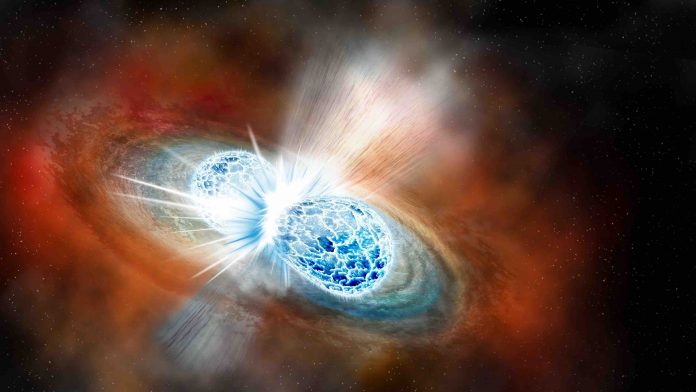University of Alberta physicists have created a new, simpler way to model collisions between neutron stars. The model will enable scientists to predict the brightness of early neutron star mergers more reliably than before — allowing telescopes to gain more information from these events.
“Studying the light and electromagnetic waves emitted from these collisions allow us to learn more about them, including how heavy elements are formed and black holes are born,” said Rodrigo Fernández, study co-author and assistant professor in the Department of Physics. “Three-dimensional models of these mergers are at the limit of computational resources, so we set out to design a simplified model that enabled faster calculations.”
Only a few neutron star mergers have been detected in gravitational waves since their initial discovery in 2015, and only one has had light detected with it along with gravitational waves. This makes it critical that scientists be able to predict which potential mergers are the best bets to focus telescopes on — and the faster, the better.
“The first few hours after a merger are predicted to emit mostly ultraviolet light, and that signal carries important information about the physics of the event,” said Fernández. “But predicting the strength of light from a potential collision requires computationally intensive calculations.”
To simplify these complex calculations, lead author and graduate student Coleman Dean worked with Fernández to model the collision on a two-dimensional grid, making approximations to the physics. Dean then carried out calculations using Canada’s most powerful supercomputer to simulate much smaller portions of the collision at a time in individual cells compared with 3D models, assessing the uncertainty in mass ejection from the calculation method used to make these predictions.
“Our main result is demonstrating that the fastest ejecta can be modelled to within 10 per cent accuracy using a grid cell size representing 20 metres — compared to the neutron star diameter of about 24 kilometres — which is not too far from what has been achieved by existing 3D studies,” said Fernández.
In terms of the brightness of the early ultraviolet signal, Fernández says that precision is enough to tell from how far away scientists could see these hours-long brightenings, giving telescopes on Earth a target.
“If we can capture the light from the first few hours after the next neutron star merger, we’ll learn a lot about the physics of these events,” said Fernández. “This new model shows exciting promise in helping to speed up our predictions and give us the best chance at catching the next neutron star collision in time.”
The study, “Resolving the Fastest Ejecta From Binary Neutron Star Mergers: Implications for Electromagnetic Counterparts,” was published in The Astrophysical Journal.















